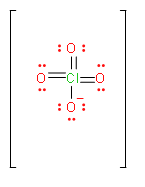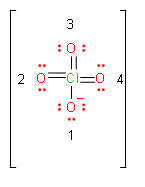
The bond order of \[Cl-O\] bond in \[ClO_{4}^{-}\] ion and the effective charge on each oxygen atom respectively are:
A. 1.75,-1
B. 1.75, -0.25
C. 1.5, -0.5
D. 2.0, -0.5
Answer
509.1k+ views
Hint: To solve these types of questions we should first draw the Lewis structure. And then after it, we then count the number of total bonds and then divide it by the number of elements in which these bonds are made with the central atom.
Step by step answer:
We can solve this question, by first drawing the Lewis dot structure of \[ClO_{4}^{-}\] ion.

In the above figure, the total number of bonds is 7. And if we try to draw different structures, these bonds will rearrange themselves between four elements. Or we can calculate it by counting the number of resonance structures this molecule can make.
$Bond\,order=\dfrac{total\,number\,of\,bonds}{total\,number\,of\,resonance\,structures}$\[\begin{align}
& Formal\text{ }charge\,of\,first\,oxygen=6-6-\dfrac{2}{2}=-1 \\
& Formal\text{ }charge\,of\,\sec ond,\,third\,and\,fourth\,oxygen=6-4-\dfrac{4}{2}=0 \\
\end{align}\]
\[Bond\,order=\dfrac{7}{4}=1.75\]
So, from the above calculation we found that the bond order of perchlorate ion is 1.75.
Now, we will calculate formal charge on each oxygen atom. First we assign numbers to oxygen atoms.

\[Formal\text{ }charge=\text{ }valence\text{ }electrons-unbonded\,electrons-\dfrac{1}{2}bonded\,electrons\]
\[\begin{align}
& Formal\text{ }charge\,of\,first\,oxygen=6-6-\dfrac{2}{2}=-1 \\
& Formal\text{ }charge\,of\,\sec ond,\,third\,and\,fourth\,oxygen=6-4-\dfrac{4}{2}=0 \\
\end{align}\]
So, effective charge on oxygen will become -0.25.
From the above discussion and calculation, we can now say that the answer of this question is option B.
Additional information:
We should know that perchlorate is a chemical compound containing the perchlorate ion \[ClO_{4}^{-}\]. The majority of perchlorates are commercially produced salts. They are mainly used for propellants, exploiting properties as powerful oxidizing agents and to control static electricity in food packaging. Most perchlorates are colourless solids that are soluble in water.
Note: We should also know about bond length. It is defined as the distance between the centres of two covalently bonded atoms. The length of the bond is determined by the number of bonded electrons (the bond order). If bond order is high, there will be stronger pull between two atoms and there will be shorter bond length. Therefore, bond length increases in the following order: triple bond < double bond < single bond.
Step by step answer:
We can solve this question, by first drawing the Lewis dot structure of \[ClO_{4}^{-}\] ion.

In the above figure, the total number of bonds is 7. And if we try to draw different structures, these bonds will rearrange themselves between four elements. Or we can calculate it by counting the number of resonance structures this molecule can make.
$Bond\,order=\dfrac{total\,number\,of\,bonds}{total\,number\,of\,resonance\,structures}$\[\begin{align}
& Formal\text{ }charge\,of\,first\,oxygen=6-6-\dfrac{2}{2}=-1 \\
& Formal\text{ }charge\,of\,\sec ond,\,third\,and\,fourth\,oxygen=6-4-\dfrac{4}{2}=0 \\
\end{align}\]
\[Bond\,order=\dfrac{7}{4}=1.75\]
So, from the above calculation we found that the bond order of perchlorate ion is 1.75.
Now, we will calculate formal charge on each oxygen atom. First we assign numbers to oxygen atoms.

\[Formal\text{ }charge=\text{ }valence\text{ }electrons-unbonded\,electrons-\dfrac{1}{2}bonded\,electrons\]
\[\begin{align}
& Formal\text{ }charge\,of\,first\,oxygen=6-6-\dfrac{2}{2}=-1 \\
& Formal\text{ }charge\,of\,\sec ond,\,third\,and\,fourth\,oxygen=6-4-\dfrac{4}{2}=0 \\
\end{align}\]
So, effective charge on oxygen will become -0.25.
From the above discussion and calculation, we can now say that the answer of this question is option B.
Additional information:
We should know that perchlorate is a chemical compound containing the perchlorate ion \[ClO_{4}^{-}\]. The majority of perchlorates are commercially produced salts. They are mainly used for propellants, exploiting properties as powerful oxidizing agents and to control static electricity in food packaging. Most perchlorates are colourless solids that are soluble in water.
Note: We should also know about bond length. It is defined as the distance between the centres of two covalently bonded atoms. The length of the bond is determined by the number of bonded electrons (the bond order). If bond order is high, there will be stronger pull between two atoms and there will be shorter bond length. Therefore, bond length increases in the following order: triple bond < double bond < single bond.
Recently Updated Pages
Electricity and Magnetism Explained: Key Concepts & Applications

JEE Energetics Important Concepts and Tips for Exam Preparation

JEE Isolation, Preparation and Properties of Non-metals Important Concepts and Tips for Exam Preparation

JEE Main 2021 July 25 Shift 1 Question Paper with Answer Key

JEE Main 2021 July 22 Shift 2 Question Paper with Answer Key

States of Matter Chapter For JEE Main Chemistry

Trending doubts
Understanding Centrifugal Force in Physics

JEE Main Marking Scheme 2026- Paper-Wise Marks Distribution and Negative Marking Details

Understanding Entropy Changes in Different Processes

Common Ion Effect: Concept, Applications, and Problem-Solving

What Are Elastic Collisions in One Dimension?

Understanding Geostationary and Geosynchronous Satellites

Other Pages
JEE Advanced Weightage 2025 Chapter-Wise for Physics, Maths and Chemistry

NCERT Solutions For Class 11 Chemistry Chapter 7 Equilibrium in Hindi - 2025-26

Understanding Excess Pressure Inside a Liquid Drop

Understanding Elastic Collisions in Two Dimensions

Devuthani Ekadashi 2025: Correct Date, Shubh Muhurat, Parana Time & Puja Vidhi

Quadratic Equation Questions with Solutions & PDF Practice Sets




